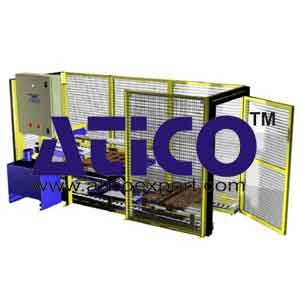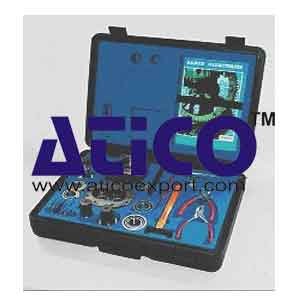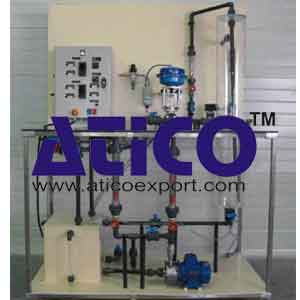Control Valve Study Bench
Categories:Control Valve Study Bench Teaching Objectives of Control Valve Study Bench Determination of the experimental KVS of the valve with and without positioner. Drawing and study of the curves. Intri...
Product
Description
Control Valve Study Bench
Teaching Objectives of
Control Valve Study Bench- Determination of the experimental KVS of the valve with and without positioner.
- Drawing and study of the curves.
- Intrinsic features of the valve.
- Qv = f(control) at constant head loss.
Feature of the installed valve :
- Qv and ΔP = f (control).
- Function of the positioner and phenomenon of hysteresis.
Functioning
- A pneumatic servomotor valve is supplied by the water network via a needle control valve. The flow is measured by a rotameter. A regulator allows to adjust the pressure of the network.
- The difference of pressure between the upstream and downstream of the control valve is measured with the help of a differential pressure transmitter with local display.
- The influence of the positioner on the answer of the valve is determined with the help of a current generator (4/20 mA) allowing the control of the control valve servomotor via an I/P converter (0,2 to 1 bar) or via a pneumatic electro-positioner.
- The device is mounted on a welded stainless steel frame, equipped of 4 adjustable feet.
Technical specifiations
- A regulator 0-3 bar of the water supply circuit with manometer.
- A needle flow adjusting valve made of stainless steel.
- A pneumatic needle control valve with variable Cv made of stainless steel.
- An electro-positioner.
- A regulator, with air oil separator and manometer.
- A differential pressure transmitter with local display and bleeding manifold.
- A rotameter (scale 60 to 600 l/h).
- An electrical cabinet, IP 55, including .
- A padlocked main switch.
- A ON light.
- An emergency stop button with key.
- A current generator (4/20 mA) with potentiometer and indicator.
- Control signal output by safety plugs.
- Technical manual in English
Essential requirements
- Power supply: 230 V, 50 Hz, 250 W
- Compressed air: 6 bar, 3 Nm3/h.
- Water: network clean water 3 bar, 20 °C, 1000 l/h.
Dimensions
- 850 x 425 x 940 mm
quick overview :
Control Valve Study Bench
Teaching Objectives of
Control Valve Study Bench- Determination of the experimental KVS of the valve with and without positioner.
- Drawing and study of the curves.
- Intrinsic features of the valve.
- Qv = f(control) at constant head loss.
Feature of the installed valve :
- Qv and ΔP = f (control).
- Function of the positioner and phenomenon of hysteresis.
Functioning
- A pneumatic servomotor valve is supplied by the water network via a needle control valve. The flow is measured by a rotameter. A regulator allows to adjust the pressure of the network.
- The difference of pressure between the upstream and downstream of the control valve is measured with the help of a differential pressure transmitter with local display.
- The influence of the positioner on the answer of the valve is determined with the help of a current generator (4/20 mA) allowing the control of the control valve servomotor via an I/P converter (0,2 to 1 bar) or via a pneumatic electro-positioner.
- The device is mounted on a welded stainless steel frame, equipped of 4 adjustable feet.
Technical specifiations
- A regulator 0-3 bar of the water supply circuit with manometer.
- A needle flow adjusting valve made of stainless steel.
- A pneumatic needle control valve with variable Cv made of stainless steel.
- An electro-positioner.
- A regulator, with air oil separator and manometer.
- A differential pressure transmitter with local display and bleeding manifold.
- A rotameter (scale 60 to 600 l/h).
- An electrical cabinet, IP 55, including .
- A padlocked main switch.
- A ON light.
- An emergency stop button with key.
- A current generator (4/20 mA) with potentiometer and indicator.
- Control signal output by safety plugs.
- Technical manual in English
Essential requirements
- Power supply: 230 V, 50 Hz, 250 W
- Compressed air: 6 bar, 3 Nm3/h.
- Water: network clean water 3 bar, 20 °C, 1000 l/h.
Dimensions
- 850 x 425 x 940 mm
Product
Reviews
add Review
reviews
No Review Yet.
Copyrights © 2025 All Rights Reserved by Atico














Product
Reviews
add Review
reviews
No Review Yet.